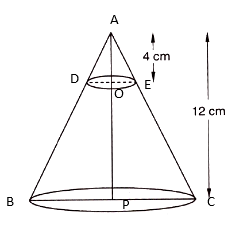In Fig. 16.74, from the top of a solid cone of height 12 cm and base radius 6 cm, a cone of height 4 cm is removed by a plane parallel to the base. Find the total surface area of the remaining solid. ![]()
In triangle ABC and ADE,
DE||BC
So, ∆ABC ~ ∆ADE
![]()
![]()
⇒ OE = 2cm

let slant height be l
Slant height, l = ![]()
![]()
⇒ l = 13.42cm
Total surface area of the frustum = πr(r + l)
= π × 6(6 + 13.42)
= 366.21 cm2
Now, for smaller cone:
Slant height, l’ = ![]()
⇒ l = 4.472 cm
So, curved surface area of smaller cone = πrl
= π × 2 × 4.472 = 28.11 cm2
Now, total surface area of the remaining frustum = total surface area of the bigger cone – curved surface area of smaller cone + area of base of smaller cone
= 366.21 – 28.11 + π (2)2
= 350.52 cm2
20